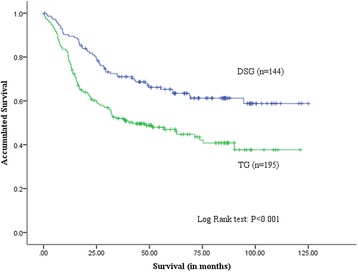The optimal extent of gastrectomy for middle-third gastric cancer: distal subtotal gastrectomy is superior to total gastrectomy in short-term effect without sacrificing long-term survival
- PMID: 28526077
- PMCID: PMC5437661
- DOI: 10.1186/s12885-017-3343-0
The optimal extent of gastrectomy for middle-third gastric cancer: distal subtotal gastrectomy is superior to total gastrectomy in short-term effect without sacrificing long-term survival
Abstract
Background: The optimal extent of gastrectomy for middle-third gastric cancer remains controversial. In our study, the short-term effects and longer-term survival outcomes of distal subtotal gastrectomy and total gastrectomy are analysed to determine the optimal extent of gastrectomy for middle-third gastric cancer.
Methods: We retrospectively collect and analyse clinicopathologic data and follow-up outcomes from a prospectively collected database at the Peking University Cancer Hospital. Patients with middle-third gastric adenocarcinoma who underwent curative resection are enrolled in our study.
Results: We collect data of 339 patients between January 2005 and October 2011. A total of 144 patients underwent distal subtotal gastrectomy, and 195 patients underwent total gastrectomy. Patients in the total gastrectomy group have longer operative duration (P < 0.001) and postoperative hospital stay (P = 0.001) than those in the distal subtotal gastrectomy group. In the total gastrectomy group, more lymph nodes are harvested (P < 0.001). Meanwhile, the rate of postoperative complications is lower in the distal subtotal gastrectomy group than in the total gastrectomy group (8% vs 15%, P = 0.047). Further analysis demonstrates that the rate of anastomosis leakage is lower in the distal subtotal gastrectomy group than in the total gastrectomy group (0% vs 4%, P = 0.023). Kaplan-Meier (log rank test) analysis shows a significant difference in overall survival between the two groups. The 5-year overall survival rates in the distal subtotal gastrectomy and total gastrectomy groups are 65% and 47%, respectively (P < 0.001). Further stage-stratified analysis reveals that no statistical significance exists in 5-year survival rate between the distal subtotal gastrectomy and total gastrectomy groups at the same stage. Multivariate analysis shows that age (P = 0.046), operation duration (P < 0.001), complications (P = 0.037), usage of neoadjuvant chemotherapy (P < 0.001), tumor size (P = 0.012), presence of lymphovascular invasion (P = 0.043) and N stage (P < 0.001) are independent prognostic factors for survival.
Conclusions: For patients with middle-third gastric cancer, distal subtotal gastrectomy shortens the operation duration and postoperative hospital stay and reduces postoperative complications. Meanwhile, the long-term survival of patients with distal subtotal gastrectomy is similar to that of those with total gastrectomy at the same stage. The extent of gastrectomy for middle-third gastric cancer is not an independent prognostic factor for survival.
Keywords: Distal subtotal gastrectomy; Middle-third gastric cancer; Overall survival; Total gastrectomy.
Figures


Similar articles
-
Is subtotal gastrectomy feasible for the treatment of gastric stump cancer located at the anastomotic site after distal gastrectomy for benign lesions?World J Surg Oncol. 2020 Feb 27;18(1):43. doi: 10.1186/s12957-020-01821-y. World J Surg Oncol. 2020. PMID: 32106866 Free PMC article.
-
[Safety and efficacy of adjuvant chemotherapy with oxaliplatin and S-1 for patients with locally advanced gastric cancer after D2 lymph nodes dissection].Zhonghua Wei Chang Wai Ke Za Zhi. 2021 Feb 25;24(2):145-152. doi: 10.3760/cma.j.cn.441530-20201016-00561. Zhonghua Wei Chang Wai Ke Za Zhi. 2021. PMID: 33508920 Chinese.
-
Robotic distal subtotal gastrectomy with D2 lymphadenectomy for gastric cancer patients with high body mass index: comparison with conventional laparoscopic distal subtotal gastrectomy with D2 lymphadenectomy.Surg Endosc. 2015 Nov;29(11):3251-60. doi: 10.1007/s00464-015-4069-1. Epub 2015 Jan 29. Surg Endosc. 2015. PMID: 25631106
-
Comparison of laparoscopy-assisted by conventional open distal gastrectomy and extraperigastric lymph node dissection in early gastric cancer.J Surg Oncol. 2005 Jul 1;91(1):90-4. doi: 10.1002/jso.20271. J Surg Oncol. 2005. PMID: 15999352 Review.
-
Comparative study between total and subtotal gastrectomy for distal gastric cancer: Meta-analysis of prospective and retrospective studies.Cir Esp (Engl Ed). 2020 Dec;98(10):582-590. doi: 10.1016/j.ciresp.2020.05.028. Epub 2020 Jun 27. Cir Esp (Engl Ed). 2020. PMID: 32600642 Review. English, Spanish.
Cited by
-
Heat Shock Factor 1 Predicts Poor Prognosis of Gastric Cancer.Yonsei Med J. 2018 Nov;59(9):1041-1048. doi: 10.3349/ymj.2018.59.9.1041. Yonsei Med J. 2018. PMID: 30328318 Free PMC article.
-
Health-related quality of life after curative resection for gastric adenocarcinoma.World J Gastroenterol. 2021 Apr 28;27(16):1816-1827. doi: 10.3748/wjg.v27.i16.1816. World J Gastroenterol. 2021. PMID: 33967559 Free PMC article.
-
Prognostic factors of poor postoperative outcomes in gastrectomies.Front Surg. 2023 Dec 1;10:1324247. doi: 10.3389/fsurg.2023.1324247. eCollection 2023. Front Surg. 2023. PMID: 38107405 Free PMC article.
-
Is subtotal gastrectomy feasible for the treatment of gastric stump cancer located at the anastomotic site after distal gastrectomy for benign lesions?World J Surg Oncol. 2020 Feb 27;18(1):43. doi: 10.1186/s12957-020-01821-y. World J Surg Oncol. 2020. PMID: 32106866 Free PMC article.
-
Lymphovascular Invasion as a Prognostic Factor in Non-Metastatic Adenocarcinoma of Esophagogastric Junction After Radical Surgery.Cancer Manag Res. 2020 Dec 14;12:12791-12799. doi: 10.2147/CMAR.S286512. eCollection 2020. Cancer Manag Res. 2020. PMID: 33364828 Free PMC article.
References
-
- Van Cutsem E, Dicato M, Geva R, Arber N, Bang Y, Benson A, et al. The diagnosis and management of gastric cancer: expert discussion and recommendations from the 12th ESMO/World Congress on Gastrointestinal Cancer, Barcelona, 2010. Ann Oncol. 2011;22(Suppl 5):v1–v9. doi: 10.1093/annonc/mdr284. - DOI - PubMed
-
- Lutz MP, Zalcberg JR, Ducreux M, Ajani JA, Allum W, Aust D, et al. Highlights of the EORTC St. Gallen International Expert Consensus on the primary therapy of gastric, gastroesophageal and oesophageal cancer - differential treatment strategies for subtypes of early gastroesophageal cancer. Eur J Cancer. 2012;48(16):2941–2953. doi: 10.1016/j.ejca.2012.07.029. - DOI - PubMed
MeSH terms
LinkOut - more resources
Full Text Sources
Other Literature Sources
Medical

